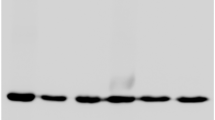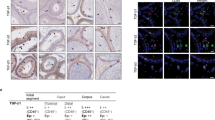Abstract
Previous reports have suggested that indoleamine 2,3-dioxygenase (IDO) activity is particularly important in mouse epididymis tissue. We show here, using reverse transcription/polymerase chain reaction assays, Northern assays, Western blotting experiments, and immunohistochemistry that IDO is indeed highly expressed in mouse epididymis, and that IDO mRNA distribution and protein location are precisely regionalized within the organ and within sub-territories of the proximal part of the epididymal duct, the so-called caput epididymidis. Within the caput epididymidis, both the principal and the apical cells have been shown to express IDO. On the contrary, tryptophan dioxygenase (TDO), a sister enzyme of IDO, is weakly and uniformly expressed in mouse epididymis and, in contrast to IDO, is also expressed in testis. In the epididymis, TDO protein expression has been found in a totally different cell type in the smooth muscle layer surrounding the epididymal tubules. Finally, IDO is not secreted into the epididymal lumen, whereas the testis-expressed TDO is present on the head of spermatozoa retrieved from the cauda epididymidis. On the basis of the various functions that have been associated with IDO/TDO, we discuss the putative impacts of IDO/TDO expression on the physiology of mammalian epididymis and spermatozoa.










Similar content being viewed by others
References
Abe K, Takano H, Ito T (1983) Ultrastructure of the mouse epididymal duct with special reference to the regional differences of the principal cells. Arch Histol Jpn 46:51–68
Aune TM, Pogue SL (1989) Inhibition of tumor cell growth by interferon-gamma is mediated by two distinct mechanisms dependent upon oxygen tension: induction of tryptophan degradation and depletion of intracellular nicotinamide adenine dinucleotide. J Clin Invest 84:863–875
Baban B, Chandler P, McCool D, Marshall B, Munn DH, Mellor AL (2004) Idoleamine 2,3-dioxygenase expression is restricted to fetal trophoblast giant cells during murine gestation and is maternal genome specific. J Reprod Immunol 61:67–77
Bubnoff D von, Koch S, Bieber S (2003) New jobs for an old enzyme: the revival of IDO. Trends Immunol 24:295–296
Christen S, Peterhans E, Stocker R (1990) Antioxidant activities of some tryptophan metabolites: possible implication for inflammatory diseases. Proc Natl Acad Sci USA 87:2506–2510
Drevet JR (2000) Glutathione peroxidases expression in the mammalian epididymis and vas deferens. In: Francavilla F, Francavilla S, Forti G (eds) Andrology: Proceedings of the 1st European Congress of Andrology. Collana Di Studi Abruzzesi, L’Aquila, pp 427–461
Drevet JR (2005) The antioxidant glutathione peroxidase family and spermatozoa, a complex story. Mol Cell Endocr (in press)
Dufaure JP, Lareyre JJ, Schwaab V, Mattei MG, Drevet JR (1996) Structural organization, chromosomal localization, expression and phylogenetic evaluation of mouse glutathione peroxidase encoding genes. C R Acad Sci III 319:559–568
Entrican G (2004) IDO: a crossroads of immunology and physiology? J Reprod Immunol 61:63–65
Frenette G, Lessard C, Sullivan R (2002) Selected proteins of “prostasomes-like particles” from epididymal cauda fluid are transferred to epididymal caput spematozoa in bull. Biol Reprod 67:308–331
Frumento G, Rotondo R, Tonetti M, Damonte G, Benatti U, Ferrara GB (2002) Tryptophan-derived catabolites are responsible for inhibition of T and natural killer cell proliferation induced by indoleamine 2,3-dioxygenase. J Exp Med 196:459–468
Grohmann U, Fallarino F, Bianchi C, Orabona C, Vacca MC, Fioretti P, Puccetti A (2003) A defect in tryptophan catabolism impairs tolerance in nonobese diabetic mice. J Exp Med 198:153–160
Hagaman JR, Moyer JS, Bachman ES, Sibony M, Magyar PL, Welch JE, Smithies O, Krege JH, O’Brien DA (1998) Angiotensin-converting enzyme and male fertility. Proc Natl Acad Sci USA 95:2552–2557
Hayaishi O (1996) Utilization of superoxide anion by indoleamine oxygenase-catalyzed tryptophan and indoleamine oxidation. Adv Exp Med Biol 398:285–289
Hermo L, Jacks D (2002) Nature’s ingenuity: bypassing the classical secretory route via apocrine secretion. Mol Reprod Dev 63:394–410
Hinton BT (1990) The testicular and epididymal luminal amino acid microenvironment in the rat. J Androl 11:498–505
Hirata F, Hayaishi O (1975) Studies on indoleamine 2,3-dioxygenase. I. Superoxide anion as substrate. J Biol Chem 250:5960–5966
Jimenez C, Ghyselinck NB, Depeiges A, Dufaure JP (1990) Immunochemical localization and association with spermatozoa of androgen-regulated proteins of MR 24000 secreted by the mouse epididymis. Biol Cell 68:171–174
Mellor AJ, Munn DH (2003) Tryptophan catabolism and regulation of adaptative immunity. J Immunol 170:5809–5813
Munn DH, Mellor AL (2004) IDO and tolerance to tumors. Trends Mol Med 10:15–18
Ozaki Y, Nichol CA, Duch DS (1987) Utilization of dihydroflavin mononucleotide and superoxide anion for the decyclization of L-tryptophan by murine epididymal indoleamine 2,3-dioxygenase. Arch Biochem Biophys 257:207–216
Rejraji H, Drevet JR (2004) Sécrétions apocrines dans le tractus génital mâle: rôles potentiels dans la maturation des gamètes. Andrologie 14:31–45
Saez F, Frenette G, Sullivan R (2003) Epididymosomes and prostasomes: their roles in post-testicular maturation of the sperm cells. J Androl 24:149–154
Sambrook J, Fritisch EF, Maniatis T (1989) Molecular cloning: a laboratory manual, 2nd edn. Cold Spring Harbor Laboratory Press, Cold Spring Harbor, NY
Singh US, Kumar MV, Panda JN (1987) Changes in angiotensin converting enzyme in testes and epididymis of rat due to serotonin administration. Andrologia 19:153–156
Sullivan R, Saez F, Girouard J, Frenette G (2005) Role of exosomes in sperm maturation during the transit along the male reproductive tract. Blood Cells Mol Dis 35:1–10
Suzuki S, Tone S, Takikawa O, Kubo T, Kohno I, Minatogawa Y (2001) Expression of indoleamine 2,3-dioxygenase and tryptophan 2,3-dioxygenase in early concepti. Biochem J 355:425–429
Ursini F, Heim S, Kiess M, Maiorino M, Roveri A, Wissing J, Flohe L (1999) Dual function of the selenoprotein PHGPx during sperm maturation. Science 285:1393–1396
Uyttenhove C, Pilotte L, Theate I, Stroobant V, Colau D, Parmentier N, Boon T, Van den Eynde BJ (2003) Evidence for a tumoral immune resistance mechanism based on tryptophan degradation by indoleamine 2, 3-dioxygenase. Nat Med 9:1269–1274
Vernet P, Rigaudiere N, Ghyselinck N, Dufaure JP, Drevet JR (1996) In vitro expression of a mouse tissue specific glutathione-peroxidase-like protein lacking the selenocysteine can protect stably transfected mammalian cells against oxidative damage. Biochem Cell Biol 74:125–131
Vernet P, Britan A, Gueux E, Mazue A, Drevet JR (2004) Dietary magnesium does not promote oxidative stress but targets apical cell within the mouse caput epididymidis. Biochem Biophys Act 1675:32–45
Yoshida R, Nukiwa T, Watanabe Y, Fujiwara M, Hirata F, Hayaishi O (1980) Regulation of indoleamine 2,3-dioxygenase activity in the small intestine and the epididymis of mice. Arch Biochem Biophys 203:343–351
Acknowledgements
The authors thank Dr. Felicity Vear for critically reading the manuscript. They are also indebted to Prof. John Aitken (Newcastle, Australia) for stimulating discussions concerning the IDO/TDO data in mouse epididymis.
Author information
Authors and Affiliations
Corresponding author
Additional information
This work was supported by grants from the French Centre National de la Recherche Scientifique and the French Ministère de l’Enseignement Supérieur et de la Recherche. A. Britan is a recipient of doctoral support from the AMPPA2 network (Ernst Schering Research Foundation and CONRAD).
Rights and permissions
About this article
Cite this article
Britan, A., Maffre, V., Tone, S. et al. Quantitative and spatial differences in the expression of tryptophan-metabolizing enzymes in mouse epididymis. Cell Tissue Res 324, 301–310 (2006). https://doi.org/10.1007/s00441-005-0151-7
Received:
Accepted:
Published:
Issue Date:
DOI: https://doi.org/10.1007/s00441-005-0151-7




